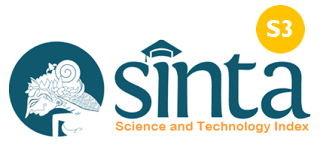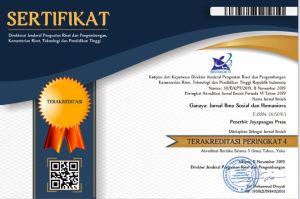Komunikasi Persuasif Sebagai Teknik Mengajar Guru Dalam Mengatasi Miskonsepsi Siswa RA Al-Badri Jember
DOI:
https://doi.org/10.37329/cetta.v7i2.3192Keywords:
Persuasive Communication, Teaching Techniques, MisconceptionsAbstract
Persuasive communication is a communication process that aims to influence, convince, or persuade others to do or believe something. The ultimate goal is to influence the attitudes, beliefs, or behaviors of the target audience. In persuasive communication, the sender of the message uses various strategies, such as logic, emotion, authority, or concrete evidence, to build a strong and convincing argument. The purpose of this study is persuasive communication as a teacher teaching technique in overcoming student misconceptions at RA Al-Badri Jember. The research method used is qualitative descriptive by taking objects at RA Al-Badri Teachers as data to see teacher interactions with students in overcoming misconceptions that occur. The results of this study are misconceptions that often occur in students in reading, writing, and arithmetic, where the teacher in overcoming cannot be separated from the concept of self, mind and society, the teacher brings the concept of himself by emphasizing the same background or the same fate as the students. In the process of persuasive communication, teachers apply persuasive communication techniques to overcome students' misconceptions in the teaching and learning process. The techniques used are association, integration, rewards and settings.
References
Alfiyani, N. (2018). Media Sosial Sebagai Strategi Komunikasi Politik. Potret Pemikiran, 22(1).
Ambarita, R. S., Wulan, N. S., & Wahyudin, D. (2021). Analisis Kemampuan Membaca Pemahaman Pada Siswa Sekolah Dasar. Edukatif: Jurnal Ilmu Pendidikan, 3(5), 2336-2344.
Aprilanti, H., Qurbaniah, M., & Muldayanti, N. D. (2016). Identifikasi Miskonsepsi Siswa pada Materi Sistem Ekskresi Manusia Kelas XI MIA SMA Negeri 4 Pontianak. Jurnal Biologi Education, 3(2), 63-77.
Astuti, L. S. (2017). Penguasaan konsep IPA Ditinjau Dari Konsep Diri Dan Minat Belajar Siswa. Formatif: Jurnal Ilmiah Pendidikan MIPA, 7(1).
Bahar, M. (2003). Misconceptions in Biology Education and Conceptual Change Strategies. Educational Sciences: Theory & Practice, 3(1), 55-64.
Derung, T. N. (2017). Interaksionisme Simbolik Dalam Kehidupan Bermasyarakat. SAPA: Jurnal Kateketik dan Pastoral, 2(1), 118-131.
Endang Soelistiyowati & Vincent Nugroho (2012)Strategi Komunikasi Untuk Sukses Menjalin Relasi. Jakarta: PT Gramedia Pustaka Utama,
Fialová, J., & Havlíček, J. A. N. (2012). Perception of Emotion-related Body Odours in Humans. Anthropologie (1962-), 50(1), 95-110.
Harianto, E. (2020). Keterampilan Membaca Dalam Pembelajaran Bahasa. Didaktika: Jurnal Kependidikan, 9(1), 1-8.
Hidayati, L. N. (2021). Prinsip-Prinsip Dasar Pendidikan Anak Usia Dini Studi Komparasi Pemikiran Maria Montessori Dan Abdullah Nashih Ulwan. Skripsi Universitas Islam Indonesia
Inah, E. N. (2015). Peran Komunikasi Dalam Interaksi Guru Dan Siswa. Al-TA'DIB: Jurnal Kajian Ilmu Kependidikan, 8(2), 150-167.
Julianingsih, D., & Isnaini, I. D. (2022). Sosialisasi Belajar Calistung Pada Anak Usia Dini Bersama Orang Tua Hebat. Bima Abdi: Jurnal Pengabdian Masyarakat, 2(1),
Kaur, G. (2013). A Review of Selected Literature on Causative Agents and Identification Strategies of Students’ Misconceptions. Educationia, 2(11), 79-94.
Kose, S. (2008). Diagnosing Student Misconceptions: Using Drawings as A Research Method. World Applied Sciences Journal, 3(2), 283- 293.
Lazwardi, D. (2017). Manajemen Kurikulum Sebagai Pengembangan Tujuan Pendidikan. Al-Idarah: Jurnal Kependidikan Islam, 7(1), 119-125.
Lestari, D. P. (2023). Miskonsepsi Baca Tulis Hitung (Calistung) pada Jenjang PAUD. JECER (journal Of Early Childhood Education and Research), 4(1), 1-10.
Muhammad, M. (2017). Pengaruh Motivasi Dalam Pembelajaran. Lantanida Journal, 4(2), 87-97.
Nurlena, N., & Fardiaz, D. (2024). Evaluation of the Role Of Consumer-Atmosphere Congruence And Social Media Influence On Purchase Intention And Recommendation Intention–Case Of Pizza Hut. International Journal of Multidisciplinary Sciences, 2(1), 1-14.
Rahayu, N. (2018). Pembelajaran Calistung Bagi Anak Usia Dini. Atfaluna: Journal Of Islamic Early Childhood Education, 1(2), 58-63.
Rosyada, D. (2004). Paradigma Pendidikan Demokratis. Jakarta: Prenada Media
Rudi Ahmad Suryadi. (2018). Ilmu Pendidikan Islam. Yogyakarta: CV. Budi Utama,
Saputri, L. A., Muldayanti, N. D., & Setiadi, A. E. (2016). Analisis Miskonsepsi Siswa dengan Certainity Response Index (CRI) pada Submateri Sistem Saraf di Kelas XI IPA SMA Negeri 1 Selimbau. Jurnal Biologi Education, 3(2), 53- 62.
Slameto. (2013). Belajar dan Faktor-Faktor yang Mempengaruhnya. Jakarta: Renika Cipta
Soemirat, S. & Suryana, A. (2015). Komunikasi Persuasif. Tangerang: Universitas Terbuka
Sudirman, D. (2014). Identifikasi Miskonsepsi Siswa pada Materi Pewarisan Sifat di Kelas IX SMP Negeri 36 Batam. Simbiosa, 3(1), 42-48
Tajuddin, Y. (2015). Walisongo dalam Strategi Komunikasi Dakwah. Addin, 8(2).
Thompson, F. & Logue, S. (2006). An Exploration of Common Student Misconceptions in Science. International Education Journal, 7(4), 553- 559.
Wafiyah, N. (2012). Identifikasi Miskonsepsi Siswa dan Faktor-Faktor Penyebab pada Materi Permutasi dan Kombinasi di SMA Negeri 1 Manyar. Gamatika, 2(2), 128- 138.
Wahyuningsih, T., Raharjo, T., & Masithoh, D. F. (2013). Pembuatan Instrumen Tes Diagnostik Fisika SMA Kelas XI. Jurnal Pendidikan Fisika, 1(1), 111-117.
West, Richard & H.Turner, Lynn. (2009). Pengantar Teori Komunikasi (Analisis dan Aplikasi). Jakarta: Salemba Humanika.
Widianto, E. (2015). Peran Orangtua Dalam Meningkatkan Pendidikan Karakter Anak Usia Dini Dalam Keluarga. Jurnal PG-PAUD Trunojoyo: Jurnal Pendidikan dan Pembelajaran Anak Usia Dini, 2(1), 31-39.
Wijaya, I. S. (2015). Perencanaan Dan Strategi Komunikasi Dalam Kegiatan Pembangunan. Lentera, 17(1).
Zaenuri, A. (2017). Teknik Komunikasi Persuasif Dalam Pengajaran. JALIE; Journal of Applied Linguistics and Islamic Education, 1(1), 41-67.
Zain, N. L. (2017). Strategi Komunikasi Persuasif dalam Meningkatkan Motivasi Belajar Siswa. Jurnal Nomosleca, 3(2).
Downloads
Published
How to Cite
Issue
Section
License
Copyright (c) 2024 Bagus Ahmad Faozan, Minan Jauhari, Kun Wazis

This work is licensed under a Creative Commons Attribution-ShareAlike 4.0 International License.
An author who publishes in the Cetta : Jurnal Ilmu Pendidikan agrees to the following terms:
- Author retains the copyright and grants the journal the right of first publication of the work simultaneously licensed under the Creative Commons Attribution-ShareAlike 4.0 License that allows others to share the work with an acknowledgement of the work's authorship and initial publication in this journal
- Author is able to enter into separate, additional contractual arrangements for the non-exclusive distribution of the journal's published version of the work (e.g., post it to an institutional repository or publish it in a book) with the acknowledgement of its initial publication in this journal.
- Author is permitted and encouraged to post his/her work online (e.g., in institutional repositories or on their website) prior to and during the submission process, as it can lead to productive exchanges, as well as earlier and greater citation of the published work (See The Effect of Open Access).
Read more about the Creative Commons Attribution-ShareAlike 4.0 Licence here: https://creativecommons.org/licenses/by-sa/4.0/.





